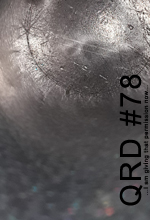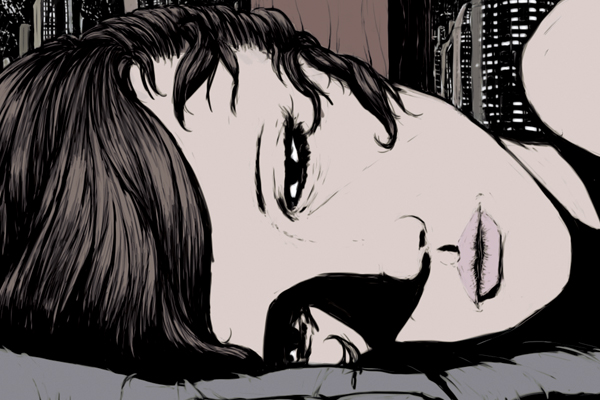



|
 |

|
Tweet |

|
Cartoonist
Interview with Chance Wyatt August 12 2017  Name: Chance Wyatt
City: Saint Paul, Minnesota Comics: census, Moving Bodies, Planetarium, Katie & the Flowers, A Bright Day on the Dark Side of the Moon, EAT ZONE Websites: ChanceWyatt.com QRD – How old were you when you first got into comics & did you always stick with them or did you come back to them? Chance – I got into comics in a serious way when I was about eleven years old when I started at a school that was across the street from a comic shop. I’ve more or less read comics ever since, but my tastes have changed on a regular basis so there’ve been periods where I only read manga or only indie books. QRD – What was the first comic book you ever bought? Chance – It was the first issue of Batman Year Two. I remember it really well. The cover had Batman standing against this bright yellow background holding a pistol. I didn’t know much about Batman at the time, but I knew that he didn’t use guns so the cover image fascinated me. QRD – How old were you when you put out your first comic? Chance – I was thirty-four. But I started writing them at twenty-three. QRD – What decade do you think produced the best comics? Chance – I would go with the eighties. & I bet that’s a popular answer. QRD – Why comics instead of just writing or drawing? Chance – I think some combo of words & pictures is just about the best way we have to tell a story. This combination wouldn’t necessarily need to be comics in the strictest sense of the word – like with word balloons & multiple images in little boxes, but I think that pictures can do things that words alone can never do. Pictures can be subtler than words & also affect a reader on more of a lizard brain sort of level. QRD – Do you see mini-comics & indie comics as paths to mainstream comics or as their own unique media? Chance – I think indie work has become more & more its own separate thing. It seems like mainstream art has gradually become more risk-averse so that the indie world is where you need to look for the more experimental, unpopular, risky stuff. QRD – How many copies of your comic do you print in your first run? Chance – I printed two thousand issues of my last book, Moving Bodies. But that’s a lot for me. Probably a lifetime supply unfortunately. QRD – How much do you think comics should cost? Chance – I’d prefer cheap, but not free. I don’t think people actually read books that they get for free. In a dream world, I’d go with a dollar a book! Of course, I personally can’t afford to make books that cheap in reality. QRD – How many books do you produce a year & how many would you like to? Chance – I’ve been on a one book a year schedule, but I’m hoping to make two next year. QRD – Do you think stories should be serialized or delivered as complete works? Chance – Complete works! & I think there’s something special about a story that you can finish in one sitting. In those sorts of stories a beginning can establish feelings that stay with you until the end. QRD – How are comic strips different than comic books & which medium do you prefer? Chance – I prefer comic books. Without page turns you see the whole story laid out in front of you at once, which makes it harder to be surprised by things. I’m hopeful for the future of panel-by-panel reading like what Comixology has been doing lately. The problem is that most books aren’t designed for that sort of reading. QRD – How long is it from when you start a comic until it’s printed? Chance – It’s usually about a year long process for me. QRD – What do you do better with your comics now than when you first started? Chance – I’m better at asking people for their opinions now. I never used to show my work to people. QRD – Do you do thumbnails? Chance – I do. & since I’m working completely digitally now, I’ve just been taking my thumbnails & using them as the basis for the final art. QRD – At what size do you draw? Chance – My latest book, Planetarium will be the first that I’ve done entirely digitally on a 13” Wacom Cintiq. QRD – What kind of pens do you use? Chance – I used to like to draw using .5 mm drafting pencils & fountain pens, but now I’m a Cintiq man all the way. QRD – What does your workstation look like? Chance – I use a Macbook Pro & a Wacom Cintiq tablet set up side-by-side with the Cintiq displaying a large view of whatever piece I’m working & my Mac displaying a zoomed-out view. QRD – At what point in the artistic process do you work digitally? Chance – I used to only color digitally, but now I do everything that way. QRD – What do you think of digital comics & webcomics? Chance – I don’t regularly read any webcomics, but I am pretty optimistic about the future of comics delivered to people primarily on tablets & phones. It seems like a nearly perfect way to get comics to people. QRD – Do you prefer working in color or black & white? Chance – I vastly prefer black & white. I think it requires more effort on the reader’s part to understand a black & white image since it’s so unnatural. Because of this, I feel like such images are often more engaging. QRD – How many different people should work on a comic & what should their jobs be? Chance – I’d like as few people as possible to work on any piece of art. & I think comics especially benefit from the writer & artist being the same person as body language & facial expressions often seems to match the dialog better. QRD – How do you find collaborators? Chance – I’ve only collaborated on one project so far. It’s a new picture book that I haven’t announced yet. With that project I gathered a few artists from my art club the Comic Readers Exchange & Enrichment Party or CREEP. QRD – How tight do you think a script should be as far as telling the artist what to draw? Chance – Well I’ve never written a script for another artist, but if I ever did, it would be very, very tight. QRD – Do you think it’s important to have a full story arc completely written before starting to draw? Chance – I wouldn’t start drawing a book that I hadn’t finished writing. QRD – What comic book person would you be most flattered to be compared to? Chance – Well, I’d say Alan Moore is my overall favorite comic writer, but Katsuhiro Otomo would be more appropriate since he both writes & draws. QRD – What do your friends & family think of your comics? Chance – They’re very supportive whenever it comes up, but we almost never talk about my work. QRD – What do you think of superheroes? Chance – I love ‘em! But I also think there’s far too many comic books about them. QRD – Marvel or DC? Chance – Marvel. QRD – What comic characters other than your own would you like to work with? Chance – I know I just said I’m a Marvel guy, but Animal Man is my favorite superhero. QRD – Ideally would you self-publish? Chance – Definitely. & I do. But ideally, a lot more people would read what I publish. QRD – What conventions do you try to attend & why? Chance – I attend all the shows that I can get to here in the Midwest. I table to get people interested enough in my work that they’ll back my Kickstarter campaigns – which is the way I can afford to self-publish. QRD – How do you feel about doing work for anthologies? Chance – I’ve never done any work for an anthology, but whenever I read them, they often seem sort of unsatisfying. I don’t know why this is really since I generally love short stories. Maybe I’m reading the wrong stuff. QRD – What do you do to promote your books? Chance – Mostly I just appear at comic cons. For my last book though I organized something I called a “concertcon” where I got indie bands & rappers together & had them play a venue while lots of my indie comic artist friends sold their work from little tables on the dance floor. QRD – Do you think your comics are well suited to comic shops or would sell better elsewhere? Chance – I’d say comic shops. Whenever I table at local comic shops I seem to sell lots more of my books than at conventions since people there are usually more interested in my art prints. QRD – What other medium would you like to see some of your comics made into (television, film, games, action figures, etc.)? Chance – I think my work would translate well into movies since I do shorter, complete stories. QRD – Do you consider yourself a comic collector or a comic reader or both? Chance – Definitely a reader. I give away most of my comics to friends. QRD – What do you see as the most viable mediums for comics distribution 10 years from now? Chance – I think we’ll see more work formatted to be read on phones. I also wouldn’t be surprised to see more subscription models like Comixology Unlimited or Marvel Unlimited appear. QRD – What would you like to see more people doing with comics? Chance – One of the strengths of comics is that you can tell small, personal stories, but with an unlimited special effects budget. Some movie examples of stories like these might be The Eternal Sunshine of the Spotless Mind or Eraserhead. QRD – Anything else? Chance – I’ll be launching a Kickstarter campaign for my new book, Planetarium later this year. All the necessary info about it will appear on my website ChanceWyatt.com
|